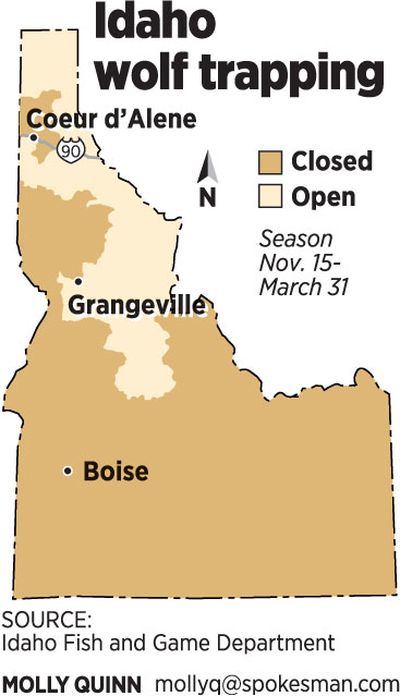Idaho wolf trapping season opens Tuesday
Prospective trappers fill all sessions of required classes

The first wolf trapping season since the predators were reintroduced to the Rocky Mountains will open in selected areas in the north half of Idaho on Tuesday.
Demand is high for the Idaho Fish and Game Department classes trappers must complete before they can purchase a wolf trapping license. The Panhandle Region already has certified 120 wolf trappers in five classes held to date.
Four more classes are scheduled in November and December, and the quota of 25 trappers in each class already has been filled, said officials in Coeur d’Alene.
“We stress rules, techniques and ethics in the classes,” said Dave Cadwallader, Fish and Game’s Clearwater Region supervisor in Lewiston.
“By the time we’re done with our classes in the Clearwater Region, we’ll have certified about 160 wolf trappers. We have trappers coming in from out of state because this is a new opportunity. You can’t trap wolves in the surrounding states.
“We let them know the spotlight is on trappers, especially wolf trappers.”
While trapping with leg-hold traps and snares is prohibited in Washington, it’s allowed in annual Idaho trapping seasons for furbearers such as beavers, mink and bobcats.
However, wolves are the first big-game animal to be opened to trapping in Idaho.
The wolf trapping season will be opened primarily in units where hunters have not succeeded in killing the quota of wolves set by wildlife officials. Trapping is set to run through March 31, but units will close early if quotas are reached.
Fish and Game officials are trying to get the word out about the wolf trapping season to hound hunters, bird dog owners and other people with pets.
“We’re telling trappers to be cautious where they put out traps, and we’re telling the public that more traps than usual will be out this season because of the new wolf trapping season,” Cadwallader said.
“The traps used for wolves are larger than the standard traps commonly used in Idaho for coyotes and furbearers, and that raises some issues for non-target animals.
“We’ve consulted with Alaska to teach trappers how to rig diverter cables that help prevent moose and deer from stepping into the wolf traps.”
Protected species such as lynx and wolverines also could be accidentally trapped. Trappers must be equipped with the gear needed to safely immobilize these dangerous animals so they can be released and set free, he said.
“Idaho is the only state in the lower 48 where wolf trapping overlaps the range of the Canada lynx, which are protected under the federal Endangered Species Act, said John Motsinger of the Defenders of Wildlife.
The group has compiled a list of techniques that help trappers avoid catching lynx, including tips on trap size and placement. The group recommends avoiding setups in areas above 4,000 feet elevation or with high numbers of snowshoe hairs, the lynx’s main prey.
Defenders as well as Fish and Game officials urge trappers to check their traps frequently. “Checking traps every 24 hours is less risky (to non-target animals) than the legal limit of 72 hours,” Motsinger said.
Domestic dogs also are vulnerable near the traps, Cadwallader said. “It would be irresponsible to let your dogs run unsupervised during the trapping season,” he said.
However, common sense dictates that in the event a person’s dog does get caught in a trap or snare, removing the dog is appropriate and expected. Dogs caught in traps may become agitated or panicked and bite their owners while they try to free them. Put a blanket or coat over your dog’s head to protect yourself from being bitten, and push down hard on the springs or lever. For releasing a dog caught in a snare, pet owners may consider carrying a set of cable-cutters.
Trappers recommend putting a coat or blanket over a dog’s head to help keep it calm and protect the rescuer from being bitten as the trap is released.
If a dog hits a snare trap head first, the cable can tighten around its neck and strangulate the animal. With a quick response, a dog owner could release the lock on the cable.
But a Montana bird hunter recently wrote in the Great Falls Tribune that he almost lost his Labrador retriever because he had difficulty releasing the lock, which had snugged up tightly and into the fur of the dog’s neck.
Idaho Fish and Game officials recommend that dog runners carry cable cutters.
But that hunter warns that cutters would need to be heavy duty – heavier than most bird hunters would want to carry – and that it might be impossible to get the cutters underneath a tightly snugged cable.
“There are going to be some interesting times out there,” Cadwallader predicted. “A trapper has to be prepared to release a mountain lion if he catches one. If you see signs that cats are in the area, it’s best not to set up there.”
It’s illegal in Idaho to tamper with traps belonging to others.